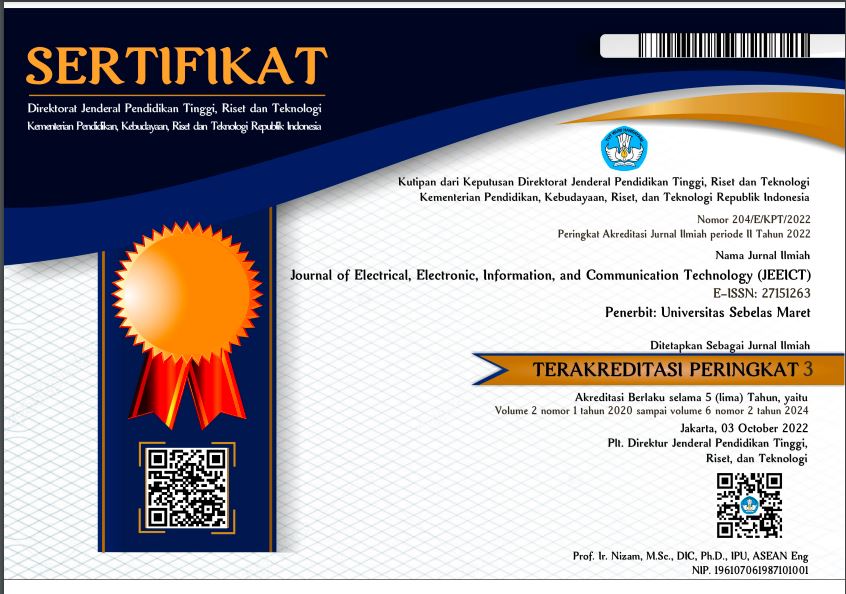Design of Smart Medical Mask Trash Can For Public Places
Abstract
The Covid-19 pandemic mainly caused the sudden rise of medical mask waste. There are some steps that can be taken to reduce and manage the waste, including dissolving the mask so it cannot be use again, reduce the risk of disease transmission, and assist the workers in managing the waste of medical mask. Therefore, this paper proposes a device that can solve all the problem, which is the “Smart Medical Mask Trash Can”. This device can be used to dissolve and disinfect the mask, as well as manage the mask waste with an easy way in accordance with health protocol. The outcome show that this device can monitor the waste with an application program on a real time that can notify and organize a schedule for automatic disinfection. This tool is suitable to be placed in public places because of its high mobility and there is a lot of medical mask's waste.
Full Text:
PDFReferences
World Health Organization. 2020. “Pembersihan Dan Disinfeksi Permukaan Lingkungan Dalam Konteks COVID-19.” https://www.who.int/docs/default-source/searo/indonesia/covid19/pembersihan-dan-disinfeksi-permukaan-lingkungan-dalam-konteks-covid-19.pdf?sfvrsn=2842894b_2.
National Academies of Sciences Engineering Medicines. 2006. “Reuse of Disposable Medical Masks During Flu Pandemic Not Recommended; Reusing Respirators Is Complicated.” Washington.
Xi, Jinxiang, Xiuhua April Si, and Ramaswamy Nagarajan. 2020. “Effects of Mask-Wearing on the Inhalability and Deposition of Airborne SARS-CoV-2 Aerosols in Human Upper Airway.” Physics of Fluids 32 (123312). https://doi.org/https://doi.org/10.1063/5.0034580.
Direktorat Kesehatan Lingkungan. 2020. “Pedoman Pengelolaan Limbah Masker Dari Masyarakat.” https://covid19.kemkes.go.id/download/Pedoman_Kelola_Limbah_Masker_Masyarakat.pdf.
Direktorat Kesehatan Lingkungan. 2020. “Pedoman Pengelolaan Limbah Rumah Sakit Rujukan, Rumah Sakit Darurat, Dan Puskesmas Yang Menangani Pasien Covid-19.”
Mulyadi. 2019. “Analisa Unjuk Kerja Mesin Pencacah Limbah Botol Plastik Dan Soft Drink Dengan Kapasitas 10 Kg/Jam.” Universitas Muhammadiyah Sumatera Utara.
Kurniawan, Heri; Margianto; Robbi, Nur. 2021. “Analisis Gearbox Pada Modifikasi Mesin Pencacah Kertas Dengan Pisau Zig-Zag.” Jurnal Nasional Teknik Elektro 16 (2).
Sofiah, and Yosi Apriani. 2019. “Pengaturan Kecepatan Motor AC Sebagai Aerator Untuk Budidaya Tambak Udang Dengan Menggunakan Solar Cell.” Jurnal Ampere 4 (1): 209–21.
Rahardi, Riyan, Dedi Triyanto, and Suhardi. 2018. “Perancangan Sistem Keamanan Sepeda Motor Dengan Sensor Fingerprint, SMS Gateway, Dan GPS Tracker Berbasis Arduino Dengan Interface Websitse.” Jurnal Coding, Sistem Komputer Untan 6 (3): 118–27.
Efendi, Mohamad Yusuf, and Joni Eka Chandra. 2019. “Implementasi Internet of Things Pada Sistem Kendali Lampu Rumah Menggunakan Telegram Messenger Bot Dan Nodemcu Esp 8266.” Global Journal of Computer Science and Technology: AHardware & Computation 19 (1): 1–12.
Puspasari, Fitri, Imam Fahrurrozi, Trias Prima Satya, Galih Setyawan, Muhammad Rifqi Al Fauzan, and Estu Muhammad Dwi Admoko. 2019. “Sensor Ultrasonik HCSR04 Berbasis Arduino Due Untuk Sistem Monitoring Ketinggian.” Jurnal Fisika Dan Aplikasinya 15 (2): 36–39.
Refbacks
- There are currently no refbacks.







